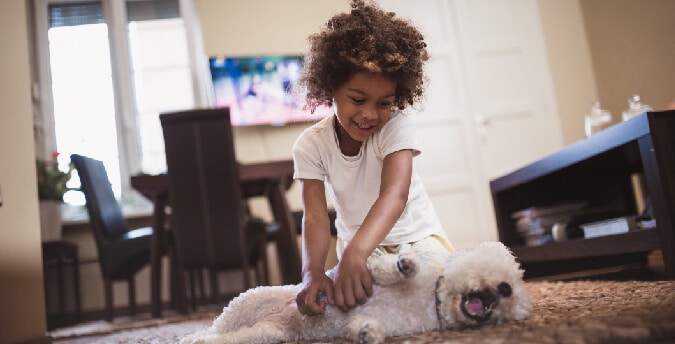Preparing Your Children for a Puppy

When you picture an ideal relationship, the image of a child running around with a puppy probably comes to mind. There’s absolutely nothing more precious than the bond that a children and puppies share; however, in many cases, that bond doesn’t develop immediately.
Puppies and children share a lot of similar traits; both are excitable, fun-loving, curious, and full of life. However, they can also be demanding and have the patience of gnats. For these reasons, it’s very important to ensure that you take the time to prepare your children for a puppy.
If you’re thinking about bringing a puppy into your family, here are some super important things that you should teach your children before your newest (and furriest) addition arrives.
GENTLENESS IS KEY
Kids often view puppies as a stuffed animal, and it’s easy to see why. They’re super furry and oh-so adorable, which can make it super tempting for a child to pick up, climb, jump over, and otherwise man- (or kid) handle a puppy.
Make sure that you make it very clear to your children how important it is for them to be gentle with their new puppy. Explain that they are living beings and that being rough with a pup could result in serious consequences; the puppy could get hurt, or he could turn around and snap those razor-like teeth. Furthermore, if your children are rough with the pup, your furry family member may end up having trust issues with them. Make sure that you are clear and firm with your expectations.
DON’T PUT HANDS NEAR MOUTHS
Puppies explore with their mouths, which is one of the reasons why they chew so much. But, it’s important that you explain to your children that they should keep their hands away from the pup’s mouth. Puppies have super sharp teeth, and even the slightest graze could result in an injury. Tell them that they should avoid pulling toys out of his mouth and that they should never torment your puppy by dangling toys in front of his mouth.
WHEN EATING, LEAVE HIM BE
Children should also be taught that they should not attempt to go near their puppy when he is in the middle of eating. This includes meals and treats. A canine will instinctually protect – and defend – his food, and if your pup thinks that his food is going to be snatched away, there’s a good chance that he’s going to react. Even the sweetest, gentlest puppy can turn aggressive at the drop of a dime if he thinks his food is in danger.
CARRYING IS A NO-NO
You wouldn’t let a child walk around with a newborn baby, would you? Well, then you shouldn’t let your kids walk around with a puppy, either. Children don’t have the strength or the steadiness to safely walk around with a puppy in-tow; and just like babies, puppies are delicate. If he should fall out of your child’s arms, he could suffer a serious injury.
That doesn’t mean that your tots can’t hold their furry best friend; just have them sit down while cuddling that sweet little guy (or gal).
CONSIDER OBEDIENCE TRAINING
You should strongly consider enrolling your entire family in obedience classes; adults, children, and of course, the puppy. Everyone can learn some very valuable lessons. Humans will learn how to properly handle and care for a puppy, and discover how they can teach him commands. Your puppy will learn that his human companions are dominant, gain an understanding of what is expected of him, and start to learn some invaluable commands, like stay, heel, come, and sit.
By following these tips, you can help your children and puppy develop an unbreakable bond and a friendship that will last a lifetime.
